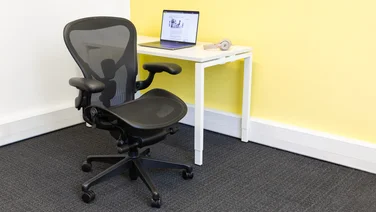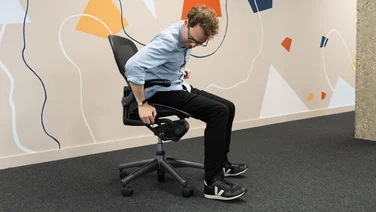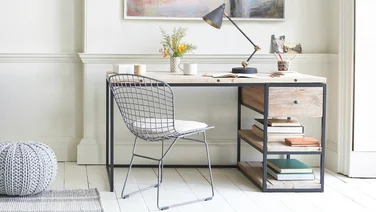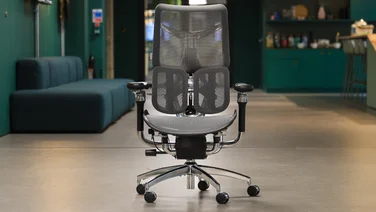To help us provide you with free impartial advice, we may earn a commission if you buy through links on our site. Learn more

When you’re working all day in the same position seated at a desk in front of a screen, you’re at risk of developing health problems from poor posture. You could find yourself suffering from repetitive strain injury in your hands and musculoskeletal issues in your neck, back and arms.
But why settle for a “one-size-fits-all” chair and desk that can trigger aches and pains and impact our health and productivity? The best office chairs aren’t all designed with ergonomics at the forefront; if an ergonomic office chair is at the forefront for you, then read on to find out what to look for and what it can do for you.
An ergonomic approach considers the way our bodies might be impacted by their regular use and then, via clever product design, makes these products as comfortable and safe as possible. Simply put, “ergonomics” is the study and application of product (or environmental) design that maximises the comfort, safety and efficiency of those who use them.
As a result, ergonomically designed desks and chairs are easier to use because they feel natural and intuitive, and, as well as protecting us from the kinds of health issues described above, provide a more enjoyable and safer experience too.
READ NEXT: Best office chairs for back pain
How will ergonomic products benefit me?
Adjustability
Just like we all have different body sizes, shapes and proportions, everyone has specific seating preferences too. Being able to adjust a chair’s height, width, depth or angle is something that helps you find the most comfortable and supportive position.
Comfort
Comfort isn’t only achieved by the structure of the product, it’s also thanks to the materials it’s made from – whether that’s the padded softness of a chair’s armrests or the breathability of the mesh covering the backrest. The tactile sensation of the product is also important – that’s why an ergonomic keyboard might have memory foam or leatherette wrist rests.
Designing a product for comfort also considers different people’s strength, taking into account how much force or pressure is needed to pull or push a lever, click a button or turn a dial.
Health and safety
By aligning your body and posture into the correct position, an ergonomic office product reduces the risk of issues like muscle strain, eye strain, neck and back pain, tendonitis and carpal tunnel syndrome. Further, it helps to combat tiredness and minimises the chance of accidents and injury.
Productivity
All of these aspects are ultimately aimed at increasing your performance. While positioned at a desk in an ergonomic work setup, thanks to a comfy seating position that minimises strain and maximises comfort, you don’t have to waste time on getting comfy. By using a setup that requires fewer repetitive movements, it also means less exertion. The absence of these distractions allow for better focus and will maximise your productivity.
READ NEXT: Best mattresses for a bad back
What do ergonomic products look like?

Most of us have come across ergonomically designed products in the workplace. Whether it’s your keyboard, mouse, laptop, desk or chair, there’s a likelihood that at least some of these items have had their ergonomics refined during their design. Ergonomic products like a mouse that mimics a handshake grip, relieves wrist pressure by naturally supporting your palm, and places the buttons and scroll wheels at the optimum position for your fingertips.
You can opt for an ergonomically designed standing desk, which allows office workers to find the perfect height to match their own body’s natural alignment. This in turn relieves neck and back pressure, keeps their core engaged, and helps them stay alert and focused.
Then there are ergonomic office chairs, designed specifically to suit your body’s dimensions. By supporting your natural posture throughout the day, you’ll feel more comfortable – which in turn reduces the risk of back pain, neck pain and repetitive strain injuries.
Of course, as we’re not all the same size and shape, an ergonomic chair is designed for adjustability in a variety of ways:
Seat angle tilt adjustment – The forward tilt rotates the pelvis, maintaining the same angle at your hips and knees
Tilt tension – Finds the optimum tension required for the chair to tilt or rock backwards, depending on your body weight
Tilt lock – Firm back support at a position that best suits your natural posture
Height adjustable seat – Finds the optimum height for your feet to be flat on the floor
Seat depth adjustment – You should be fully supported by the backrest when sitting, so those with shorter thighs need a smaller seat depth to make sure both their thighs and back are in contact with the chair
Backrest angle adjustment – A slight recline allows the backrest to take some of your upper body’s weight, reducing pressure
Height adjustable armrests – Supports arm weight and relieves pressure
Width adjustable armrests – Positions the armrests at the correct distance from your body to avoid splayed elbows and unevenly bent wrists
Padded armrests – Relieves pressure on the forearms
Lumbar support – Mimics the back’s natural S curvature to provide support
Lumbar height adjustment – Changes the height of the lumbar support to better fit your spine’s curve
Headrest height – Provides support for the neck and shoulder to help relax muscles in that area
READ NEXT: How to stop an office chair squeaking
How to create an ergonomic work area
If you’re using ergonomic office products, it makes sense to create a work environment that’s ergonomic too.
Work comfortably within your reach

When working at a desk, there’s actually an ergonomic “primary reach zone” that stretches around you – this describes the wide radius you can comfortably reach while sitting neutrally. Placing all your work tools here – keyboard, mouse, notepad and any other frequently used objects – means your arms remain in the correct range of motion for most of your working day. Beyond this radius is where you should place the objects you don’t need to reach for as often, like your phone, headphones, coffee mugs and your monitor screen – all of which fall into the “secondary” or “maximum reach zone”. The third area – the “extended reach zone” – is where everything else should be placed, including desk lamps, potted plants and rarely used stationery.
Regulate temperature and maximise natural light
Along with your desk, chair and tech needs, why not consider the sensory aspects of the area you work in? That might mean the temperature of the room, the empty space both on and around your desk, how light it is and whether the source of illumination is natural (better) or artificial.
READ NEXT: How to repair an office chair
Reduce glare and distractions
Screen glare should be avoided where you can (use a screen filter to avoid eye strain) and if external noises are a distraction, try using headphones to channel some ambient noise and help maintain your focus.
Make regular movement part of your working day
Don’t just sit there – taking regular breaks every 30 minutes to walk around and move your body reduces eye strain, the chance of headaches and muscle pain. Doing so also gets the blood pumping and gives you an overall stretch, which never goes amiss if you work sitting at a desk for 40 hours a week.
For fidgety people, using a kneeling chair also helps to keep you active while sitting. As there’s no backrest on these, your core muscles are continually engaged which both improves your posture and helps to reduce lower back pain.
READ NEXT: How to adjust an office chair
Are ergonomic products more expensive?
They are, but there’s a good reason for that. Ergonomic products have been designed specifically to help your body remain as comfortable and unstrained as possible for long periods of time. As a result, “buying ergonomic” is essentially investing in your own body and future health – and can we really put a price on that?





